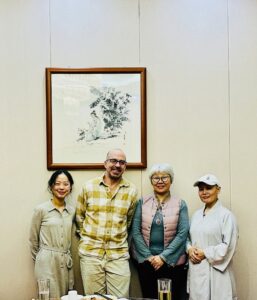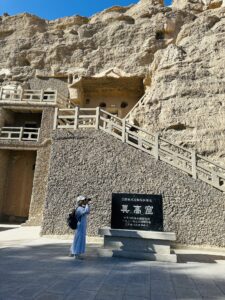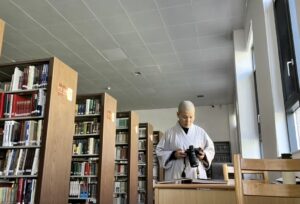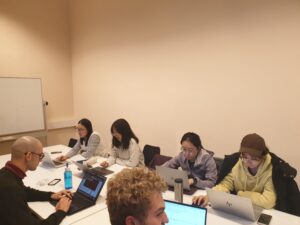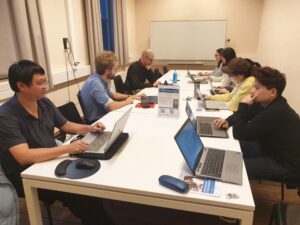Buddhism is a driving force in many regions of the world. Yet many aspects of it remain unknown. This is especially true when it comes to everyday praxis, to people now and in the past who incorporate Buddhism into their daily lives. This is the common thread throughout this lecture series. For anyone interested in religions of the world!
Organized by the Ghent Centre for Buddhist Studies, Permanent Training in Buddhist Studies lecture series – 2025 will take place on Tuesdays, 19:30-21:30 CET, in the Atrium of the Faculty of Arts and Philosophy Library (Rozier 44). Please visit the website of the Humanities Academy to register.
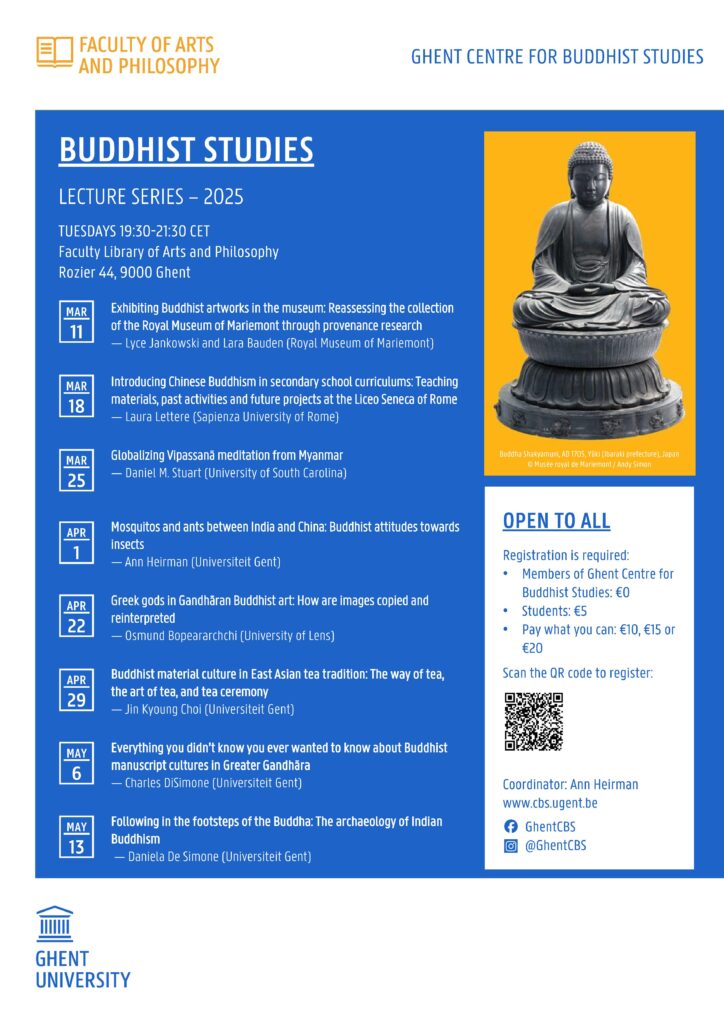
Tickets
- Members of Ghent Centre for Buddhist Studies: €0 (registration is required)
- Students: €5
- Pay what you can: €10, €15 or €20
Program
11 March 2025 – Exhibiting Buddhist Artworks in the Museum: reassessing the collection of the Royal Museum of Mariemont through provenance research
- by Lyce Jankowski and Lara Bauden (Royal Museum of Mariemont)
The Royal Museum of Mariemont houses a significant collection of Buddhist art, acquired by its founder, Raoul Warocqué, in the early 20th century. This collection includes statuary from various regions of Asia, such as Gandhara, Thailand, Vietnam, China, Japan, and Nepal, but, despite its richness, it has been poorly documented. Through provenance research, we have re-evaluated the identification and dating of many of these items, revealing surprising discoveries. The ongoing exhibition Sensing the Buddha showcases a selection from this collection. Although displayed in a secular museum, the exhibition aims to respect the sacred dimensions of the objects.
Tuesday 18 March 2025 – Introducing Chinese Buddhism in Secondary School Curriculums: Teaching Materials, Past Activities and Future Projects at the Liceo Seneca of Rome
- by Laura Lettere (Sapienza University of Rome)
The teaching of Chinese Language and Civilization in Italian high schools has a twenty-year history – as of 2018, around 200 Italian schools included Chinese language instruction in their curriculum. This presentation will briefly outline the structure of the Chinese Language and Civilization curriculum in linguistic high schools in Italy, focusing specifically on the teaching of Chinese culture, and particularly Chinese Buddhism, to students in their third, fourth, and fifth years of high school.
The presentation will address the treatment of Chinese Buddhism in textbooks and the educational activities planned for the third and fourth years, where the subject intersects with cross-cutting topics such as cultural otherness, gender equality, emotional management, and traditional interdisciplinary themes like travel. The analysis of Chinese-language texts provides opportunities for in-depth discussions on narratology and style.
The discussion will explore how a predominantly religious theme can be adapted for multicultural classrooms, including through field trips to visit places of worship within the Chinese community in Rome. The presentation will conclude with the introduction of a planned educational activity for the 2025/26 school year, illustrating how teachers’ specific research interests and fieldwork experiences in China or other Sinophone countries can offer fresh insights and practical tools to meet the educational needs of fifth-year high school students.
Tuesday 25 March 2025 – Globalizing Vipassanā meditation from Myanmar
- by Daniel M. Stuart (University of South Carolina)
In this lectureI extend previous research on the history of mid-twentieth-century Burmese vipassanā (insight) meditation through an exploration of some of the particularities of the meditation-teaching models of the lay meditation master and first Accountant General of Independent Burma, Sayagyi U Ba Khin (1899–1971). While much scholarship has glossed over the charismatic healing modalities of U Ba Khin and his students, I argue here that charismatic healing was at the center of U Ba Khin’s teaching practices. What is more, U Ba Khin’s charismatic approach to meditation and meditation teaching was embedded in a missionary theory that shared thematic elements with esoteric weizzā (wisdom-power) traditions oriented to spiritual practices that might lead to world-domination in a postcolonial Burmese context. Drawing primarily on U Ba Khin’s oral Burmese Dharma talks, I suggest that U Ba Khin’s mission to spread vipassanā in the twentieth century can best be understood as the project of a weizzā-dho (Pāli: vijjādhara), a wizard wielding a particularly powerful form of vipassanā-vijjā (the wisdom-power of insight meditation). I also explore how the post-war context of U Ba Khin’s mission, his concerns around the fallout of the use of nuclear weapons in the Asian theatre, and his attempt to scientize Buddhist theories of matter, influenced how he understood the process of vipassanāmeditation.
Tuesday 1 April 2025 – Mosquitos and Ants Between India and China: Buddhist attitudes Towards Insects
- by Ann Heirman (Ghent Centre for Buddhist Studies)
Buddhist texts generally prohibit the killing of all sentient beings. This is certainly the case in vinaya (disciplinary) texts, which contain strict guidelines on the preservation of all human and animal life. When these vinaya texts were translated into Chinese, they formed the core of Buddhist behavioural codes, influencing both monastic and lay followers. Chinese vinaya masters, such as Daoxuan 道宣 (596–667) and Yijing 義淨 (635–713), wrote extensive commentaries and accounts, introducing Indian concepts into the Chinese environment. In this lecture, we focus on an often neglected aspect of inflicting harm on sentient beings: namely, the injury that may be caused to some of the world’s smallest animals — insects. Some insects produce economically valuable products, such as silk and honey; others, such as mosquitoes and ants are annoying or dangerous; and still others are innocent victims of essential human activities, such as earthworms that are killed when farmland is tilled. Yet, all of these are sentient beings that — according to Buddhist principles — should not be harmed or killed. What this implies for Chinese vinaya masters, and especially the highly influential Daoxuan, is the core question of this lecture. As we will see, their responses are mixed, but they always attempt to remain true to the basic principles of Buddhism.
Tuesday 22 April 2025 – Greek gods in Gandhāran Buddhist art: How are images copied and reinterpreted
- by Osmund Bopeararchchi (University of Lens)
The Gandhāran Budhist art flourished under the auspicious political domination of the Kuṣāṇ Empire in a vast region which was once the cradle of diverse political supremacies and civilisations, such as those of the Achaemenids, the Greeks, the Scythians and the Parthians. The presence of Western powers in the fertile lands of Gandhāra and Greater Gandhāra for many generations gave birth to an innovative art characterized by naturalism and narrative power. The specificity of Gandhāran art is also its ability to narrate an Indian story, namely the life story of the Guatama Buddha, his previous lives and peripheral stories using both Western and Indian artistic motifs. The presence of Greeks in the area since the conquest of Alexander the Great is an important historical fact. This talk highlights how, thanks to these cross-cultural interactions, a new complex art with an iconographic program illustrated by its singularity was born in Gandhāra. The purpose of this presentation is to examine how Greek gods and heroes were used to dramatize the life story of Gautama Buddha.
Tuesday 29 April 2025 – Buddhist Material Culture in East Asian Tea Tradition: The Way of Tea, the Art of Tea, and Tea Ceremony
- by Jin Kyoung Choi (Ghent Centre for Buddhist Studies)
Europeans have been enjoying tea since the Dutch East India Company first introduced it to the continent in 1610. However, the historic development of tea culture as practiced in
East Asia remains relatively underexplored and is often perceived as exotic by the global majority. Despite growing interest, particularly among younger generations in the West, there is a lack of comprehensive academic research and reliable publications to deepen our understanding of the living traditions of “skillfully” brewing and enjoying tea. In this lecture,
We will delve into the history and evolution of one of the most refined tea practices, the Gongfu tea ceremony, which has spread from China across East Asia. We will explore how Buddhism shaped the development of tea culture in China, Taiwan, Japan and Korea, while also examining how tea rituals have been adapted within various Buddhist schools, including Chan (Zen) and Pure Land traditions. Furthermore, the Gongfu tea ceremony will be discussed in relation to other religious, ethnological, and anthropological contexts, shedding light on its socio-political significance and its role in fostering communal harmony.
Tuesday 6 May 2025 – Everything You Didn’t Know You Ever Wanted to Know about Buddhist Manuscript Cultures in Greater Gandhāra
- by Charles DiSimone (Ghent Centre for Buddhist Studies)
Buddhism flourished well into the first millennium of the Common Era throughout the area of Greater Gandhāra, an area encompassing modern day Afghanistan, Pakistan, and Northern India. During this period, a great multitude and variety of Buddhist literature circulated throughout the area. This talk will present a curated view for non-specialists into the nature of textual transmissions that were circulating throughout Greater Gandhāra in the middle of the first millennium by exploring recently discovered manuscript artefacts from the area.
Tuesday 13 May 2025 – Following in the Footsteps of the Buddha: The Archaeology of Indian Buddhism
- by Daniela De Simone (Ghent Centre for Buddhist Studies)
This lecture explores the archaeology of Indian Buddhism through an examination of key sites associated with the life and teachings of Śākyamuni, the historical Buddha. From his birthplace at Lumbini, to the site of his enlightenment at Bodhgaya, his first sermon at Sarnath, and his final passing at Kushinagar, these sacred locations provide invaluable insights into the material cultures and ritual landscapes of early Buddhism. The discussion will focus on archaeological excavations, structural remains, inscriptions, and artistic developments that shaped the Buddhist pilgrimage circuit in South Asia. Additionally, the lecture will explore Emperor Ashoka Maurya’s role as the first Buddhist sovereign and his patronage in the monumentalisation and expansion of these sites.
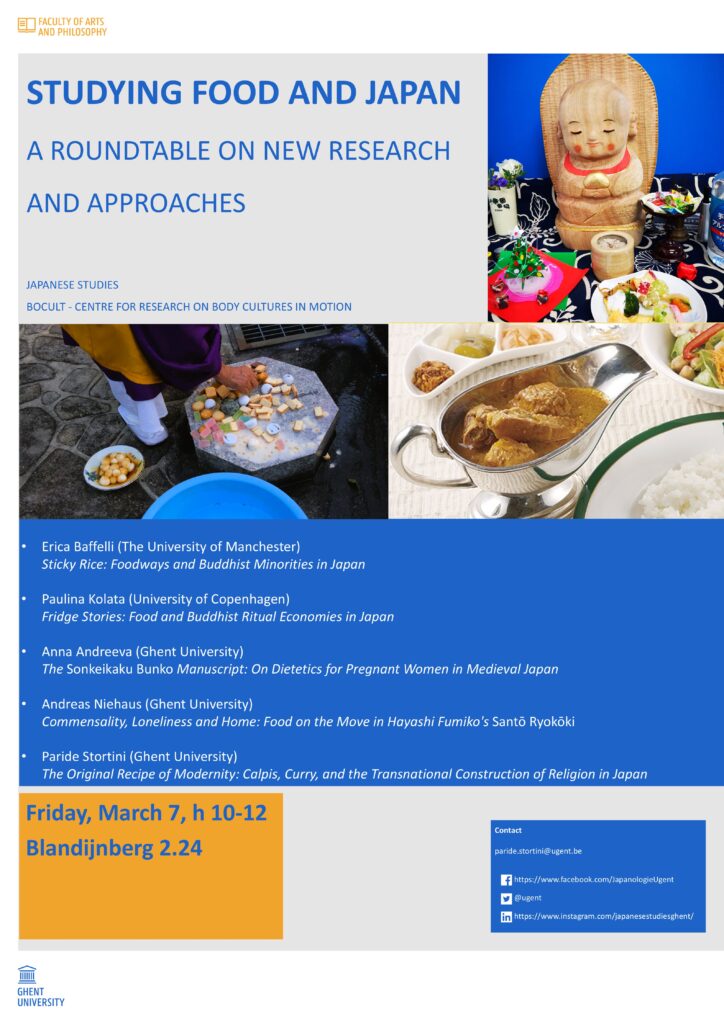
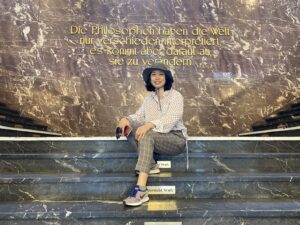
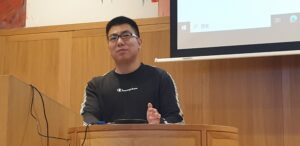
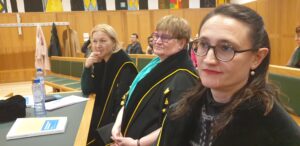
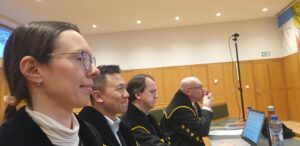
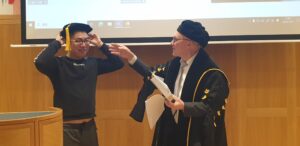
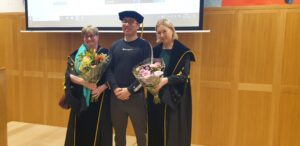
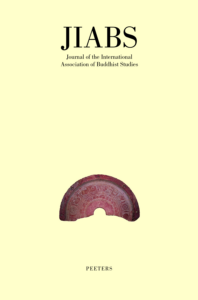 Articles from two GCBS researchers have just been published in the
Articles from two GCBS researchers have just been published in the 
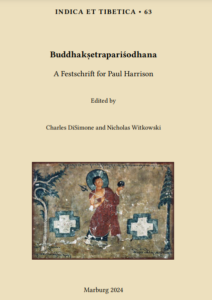 New Book Announcement:
New Book Announcement: 